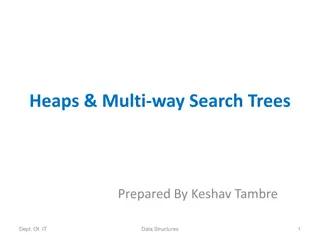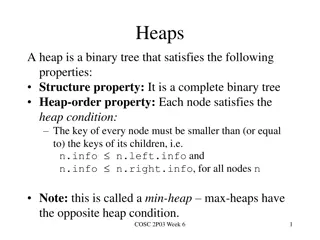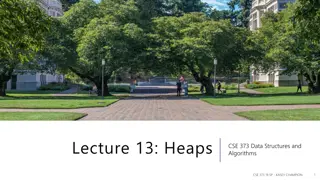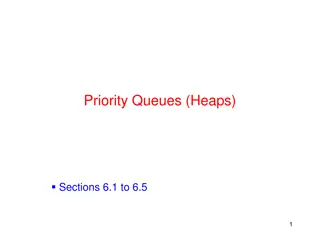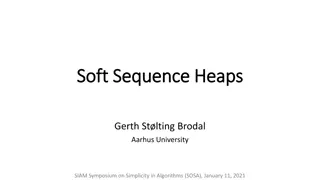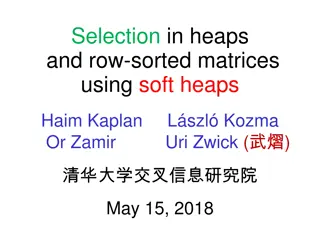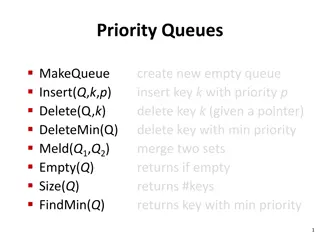Heaps - A Comprehensive Overview
Heaps are hierarchical data structures that prioritize the most important elements for quick access. This article explores the concept of heaps, types of heaps (such as min and max heaps), abstract data type, practical uses over binary search trees, storing heaps in memory with arrays, manipulations like insert and extracting max, building a max-heap in O(n) time, and the process of heapifying elements. Visual examples and explanations make the understanding of heaps clearer and emphasize their significance in programming.
Download Presentation

Please find below an Image/Link to download the presentation.
The content on the website is provided AS IS for your information and personal use only. It may not be sold, licensed, or shared on other websites without obtaining consent from the author.If you encounter any issues during the download, it is possible that the publisher has removed the file from their server.
You are allowed to download the files provided on this website for personal or commercial use, subject to the condition that they are used lawfully. All files are the property of their respective owners.
The content on the website is provided AS IS for your information and personal use only. It may not be sold, licensed, or shared on other websites without obtaining consent from the author.
E N D
Presentation Transcript
What is a heap? Always keep the thing we are most interested in close to the top (and fast to access). Like a binary search tree, but less structured. No relationship between keys at the same level (unlike BST).
Types of heaps Min heap: priority 1 more important than 100 Max heap: 100 more important than 1 We are going to talk about max heaps. Max heap-order property Look at any node u, and its parent p. p.priority u.priority p:7 u:3
Abstract data type (ADT) We are going to use max-heaps to implement the (max) priority queue ADT A priority queue Q offers (at least) 2 operations: Extract-max(Q): returns the highest priority element Insert(Q, e): inserts e into Q Every time an Insert or Extract-max changes the heap, it must restore the max-heap order property. ( Prove by induction on the sequence of inserts and extract-maxes that occur.)
What can we do with a heap Can do same stuff with a BST why use a heap? BST extract-max is O(depth); heap is O(log n)! When would we use a BST? When we need to search for a particular key.
Storing a heap in memory Heaps are typically implemented with arrays. The array is just a level-order traversal of the heap. The children of the node at index i are at 2i and 2i+1.
Example time Interactive heap visualization Insert places a key in a new node that is the last node in a level-order-traversal of the heap. The inserted key is then bubbled upwards until the heap property is satisfied. Extract-max removes the last node in a level- order-traversal and moves its key into the root. The new key at the root is then bubbled down until the heap property is satisfied. Bubbling down is also called heapifying.
Building a max-heap in O(n) time Suppose we want to build a heap from an unsorted array: 10, 2, 7, 8, 6, 5, 9, 4, 3, 11. We start by interpreting the array as a tree.
Building a heap: a helper function I:3 Precondition: trees rooted at L and R are heaps Postcondition: tree rooted at I is a heap Case 1: max = L Need to fix L:7 R:5 MaxHeapify(A,I): L = LEFT(I) R = RIGHT(I) I:7 If L heap_size(A) and A[L] > A[I] then max = L else max = I If R heap_size(A) and A[R] > A[max] then max = R Case 2: max = I Heap OK! L:3 R:5 I:5 Case 3: max = R Need to fix If max is L or R then swap(A[I],A[max]) MaxHeapify(A,max) L:3 R:7
Proving MaxHeapify is correct How would you formally prove that MaxHeapify is correct? Goal: Prove MaxHeapify is correct for all inputs. Correct means: if the precondition is satisfied when MaxHeapify is called, then the postcondition will be satisfied when it finishes. How do we prove a recursive function correct? Define a problem size, and prove correctness by induction on problem size. Base case: show function is correct for any input of the smallest problem size. Inductive step: assume function is correct for problem size j; show it is correct for problem size j+1.
Proving MaxHeapify is correct - 2 Let s apply this to MaxHeapify. Problem size: height of node I. Base case: Prove MaxHeapify is correct for every input with height(I) = 0. Inductive step: Let A and I be any input parameters that satisfy the precondition. Assume MaxHeapify is correct when the problem size is j. Prove MaxHeapify is correct when the problem size is j+1.
Proving MaxHeapify is correct - 3 I:3 Precondition: trees rooted at L and R are heaps Postcondition: tree rooted at I is a heap Case 1: max = L Need to fix L:7 R:5 MaxHeapify(A,I): L = LEFT(I) R = RIGHT(I) I:7 If L heap_size(A) and A[L] > A[I] then max = L else max = I If R heap_size(A) and A[R] > A[max] then max = R Case 2: max = I Heap OK! L:3 R:5 I:5 Case 3: max = R Need to fix If max is L or R then swap(A[I],A[max]) MaxHeapify(A,max) L:3 R:7
The main function BUILD-MAX-HEAP(A): for i = heap_size(A)/2 down to 1 MaxHeapify(A,i)
2d nodes at depth d Node at depth d has height h-d Cost to heapify one node at depth d is c(h-d) Don t care about constants... Ignoring them below Cost to heapify all nodes at depth d is 2d (h-d)


